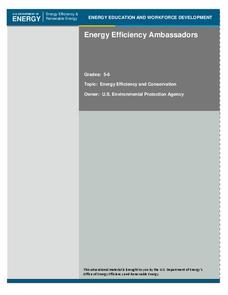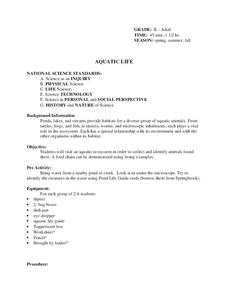Curated OER
Hawaiian Hot Spots
Students describe how plate tectonics contribute to the development of volcanoes. In this earth science lesson, students examine the map of Hawaii and explore the physical and biological environment there. They write a story about an...
Curated OER
Atlatl (Native Americans)
Students discover what an atlatl is and how to use it. In this Native American instructional activity, students discuss the history of the Native American atlatl and practice throwing with it. Students will analyze the effects of the...
Curated OER
Voyage: A Journey Through Our Solar System
Thoroughly written, this plan walks you through every detail of having your high school astronomers design scale models of the solar system. Complete instructions on building to scale, lesson procedures, and associated worksheets are all...
University of Colorado
Terra Bagga
Earth's magnetic poles switch positions about every 200,000—300,000 years. In the activity, groups create a planet with a magnetic field. Once made, they use a magnetometer to determine the orientation of the planet's magnetic field....
University of Colorado
Can Photosynthesis Occur at Saturn?
In the 19th activity of 22, learners determine if distance from a light source affects photosynthesis. Participants capture oxygen in straws and find that the amount of water the gas displaces is proportional to the rate of photosynthesis.
University of Colorado
The Jovian Basketball Hoop
A radio receives radio signals, converts them to an electrical signal, then converts this signal to a sound signal, and amplifies the sound so people can hear it. Class members use this information to create a short-wave radio antenna...
Curated OER
Building And Launching a Model Rocket
Students are introduced to the basic parts of rockets and the physical forces at work in the flight of rockets. They build and launch a model rocket and discuss the challenges of launching a real rocket.
Curated OER
Is It There?
Students participate in a lesson designed to illustrate these concepts using simple materials. They use Science process skills to observe, measure, predict, make inferences, and communicate while completing the activity. Proper safety...
Curated OER
Energy Efficiency Ambassadors
Pupils consider how to cut their energy use. In this physical science lesson, students investigate the connections between energy use and climate changes. Pupils compute the actual electrical energy consumption of 2 bulbs and consider...
Curated OER
Aquatic Life
Students explore aquatic life. In this science instructional activity, students visit an aquatic ecosystem and collect animals found there. Students create a food chain for the aquatic ecosystem.
Curated OER
A Comparison of Polymeric Liquids with Newtonian Liquids
Learners perform several tests on liquids. In this general science lesson, students compare the properties of polymeric and nonpolymeric liquids. They explain the composition and importance of macromolecules.
University of Colorado
Looking Inside Planets
Researchers use scientific data to understand what is inside each of the planets. The first in a series of six, this instructional activity builds off of that concept by having pupils use a data table to create their own scale models of...
University of Colorado
Looking Inside Planets
All of the gas giant's atmospheres consist of hydrogen and helium, the same gases that make up all stars. The third in a series of 22, the activity challenges pupils to make scale models of the interiors of planets in order to...
University of Colorado
Happy Landings: A Splash or a Splat?
Huygens spacecraft landed on Saturn's moon Titan in 2005, making it the farthest landing from Earth ever made by a spacecraft. In this hands-on activity, the 12th installment of 22, groups explore how density affects speed. To do this,...
University of Colorado
Using Spectral Data to Explore Saturn and Titan
Saturn's rings are made of dust, ice, and solid chunks of material. Individuals use spectrographs in this final installment of 22 lessons to determine the atmospheric elements. They analyze spectrums from Titan's atmosphere and Saturn's...
NASA
Supernova Chemistry
By measuring the wavelength, frequency, and intensity of electromagnetic radiation, scientists determine the temperature, density, and composition of far away items. Scholars rotate through ten lab stations using a spectroscope at each...
Curated OER
Activity One -- Fundamentally Speaking
In this science worksheet, learners examine how the universe is bound with the atomic particles and focus upon the findings of two historical scientists.
Curated OER
Hearts in Motion
Students participate in cardiovascular activities. In this physical education lesson, students are divided into groups and brainstorm activities to get their heart rate up. Students demonstrate the activity for classmates.
Curated OER
Alcohol and Driving: When to Say No
Students inspect the factors involved in blood alcohol concentration. They observe a Web-based driving simulation and discover the physical and mental impairments caused by alcohol. They calculate the blood alcohol content in various...
Curated OER
Describe the Perfect Pathogen
Students develop a pathogen based upon their knowledge of pathogens and after presenting it to the class, they then suggest ways that the pathogen might be combated. Next they identify possible physical or behavioral changes in a...
University of Colorado
The Moons of Jupiter
Middle schoolers analyze given data on density and diameter of objects in space by graphing the data and then discussing their findings. This ninth installment of a 22-part series emphasizes the Galilean moons as compared to other objects.
Curated OER
The Cigar Box Guitar
Students correlate string tension with sound pitch. They describe how string mass (thickness) effects sound pitch and demonstrate an understanding of the physics of the acoustic guitar. They see that sound is produced by vibrations.
Curated OER
Howdy Neighbor
High schoolers role play a power grid set up to show how increased load affects the grid. In this physics instructional activity, students explain the importance of electricity in their daily lives. They identify the key components of...
Science Friday
Colorful Chromosomes
Everything is in the genes. Individuals observe 14 different traits of themselves. Using pipe cleaners and beads, the learners create models of a chromosome representing their traits. The class then compares and contrasts everyone's...

























